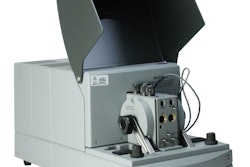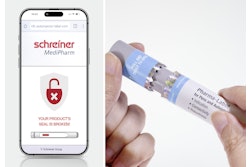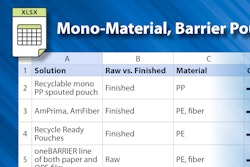Being round, of course, they tend to spin on a conveyor. That means at least two and likely three cameras need to be mounted to a conveyor in order to capture the 2D DataMatrix code from any possible angle. Experts estimate this need for additional camera coverage can increase your total serialization budget by 5% or 10%, depending on how many lines are running round bottles.
A second issue pertains to how codes are printed onto folding cartons. Some have found that the printing area is not always uniformly presented to the print head when the printing panel is located on a closure flap of the carton. There can be varying degrees of curvature following closure. This curvature has an impact on the online inspection process, which is sensitive to changes in the light that is required to fully grade the 2D code. The result can be false rejects of otherwise acceptable cartons. Adjustments may be necessary to improve package handling to address the problem at the coding or lighting stage.
Specifying vision systems
When specifying a vision system, it is important to consider factors such as software accuracy, reliability, and local factory support.
Generally, today’s vision systems are divided into two groups: PC-based and smart camera. Key differentiators between the two include architecture, cost, capability, and development environment. The primary architectural difference between PC-based vision and smart cameras is one of centralized versus distributed image processing.
PC-based systems generally multiplex industrial cameras on a production line to a single processor to process images. These systems are often sold in proprietary industrial computers and offer limited redundancy for hard drives, lack support for virus/malware protection (a problem when networked), and use embedded operating systems that are not easily updated. Some include swappable drives, which present a risk for validated systems if each drive has not been validated to confirm its configuration.
Smart cameras (sometimes referred to as distributed, embedded, or IP cameras) are self-contained and include a CPU, image sensor, and communications and network connectivity, and do not require a PC. They combine distributed processing with high-speed networking to provide highly scalable systems.
Both approaches have advantages. PC-based machine vision systems provide great flexibility in the number of options users can select (e.g., line scan or area scan camera). They are easily used with third-party software, and tend to offer more power and speed due to sophisticated processors. PC performance increases with each boost in processor speed, which makes new PC-based vision systems well suited for the most complex or mathematically intensive applications.
However, because PC technology changes so rapidly, it is not as easily replicated as off-the-shelf smart cameras. Smart camera systems cost less to purchase and implement than their PC-based counterparts. They are simpler to operate, maintain, and integrate into the manufacturing environment. As they are less complex than computers, they are also more reliable, with fewer components presenting operational risk.
PC technology offers a central human machine interface (HMI) to centralize setup and configuration. Discrete smart cameras on the other hand may require longer to configure each system. Also, older PC technology, especially systems in proprietary industrial machine housing, may impose technology limitations and older risky embedded operating systems, and may not take advantage of advances in technology. (Would you buy a phone from 2006 today?)
Smart cameras can offer these advantages:
• Smart camera vision systems can be less expensive to install, less complex to validate, and less costly to maintain.
• With advancements in miniaturization and the power of digital signal processors, traceability applications such as code reading, text verification, mark quality assessment, and label inspection can be accomplished economically.
Because they are solid state, smart cameras can provide a more stable platform than PC-based alternatives.
Configurable, rather than programmable, smart camera vision systems can make it easier to accommodate changes in regulations and standards.
• Most advanced vision systems now offer advanced networking and communication capabilities and powerful factory integration tools.
• Cameras are now available with gigabit Ethernet 2.0 transfers at speeds of up to 125 MB/s. These cameras deliver high bandwidth with very long cable lengths at low cost without the use of repeaters. Connectivity is limited only by the number of available ports on your Ethernet switch.
Liked this article? Download the entire playbook here.






















